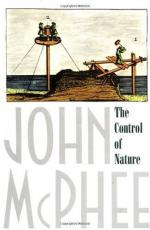
|
| Name: _________________________ | Period: ___________________ |
This test consists of 15 multiple choice questions and 5 short answer questions.
Multiple Choice Questions
1. The Civil Defense Council in the Reykjavik National Emergency Center is established in 1962 as what?
(a) Command-post bomb shelter.
(b) Volcano eruption monitoring station.
(c) Storm-monitoring communication headquarters.
(d) Natural disaster preparedness center.
2. What is Thorbjorn Sigurgeirsson's idea to stop the flow of lava?
(a) Digging channels and ditches.
(b) Building a metal wall.
(c) Redirecting it.
(d) Cooling it.
3. Valdimar Jonsson is a professor of what?
(a) Volcanic eruptions.
(b) Icelandic folklore.
(c) Thermal fluids.
(d) Mob mentality.
4. What do work crews call the two-million ton floating mountain that breaks off during the 1973 eruptions?
(a) Dettifoss the Mountain.
(b) Haukadalur the Ominous.
(c) Surtsey the Fiery.
(d) Flakkarinn the Wanderer.
5. During the 1973 volcanic eruptions, many farmers and fishermen leave Heimaey:
(a) Against their will.
(b) For a day only.
(c) Never to return.
(d) For the first time.
6. With "City Flow" moving towards them in Heimaey, what do pumping crews do?
(a) Send an emergency request for more crews and equipment.
(b) Dismantle and move equipment to save it.
(c) Board a ship and leave.
(d) Abandon efforts and run away.
7. Thorbjorn Sigurgeirsson is a native of which country?
(a) Sweden.
(b) Greenland.
(c) Iceland.
(d) Finland.
8. What ultimately happens to the moving piece of mountain on Vestmannaeyjar?
(a) Hits another mountain and stops.
(b) Completely destroys the town and stops.
(c) Breaks up into smaller, non-moving pieces.
(d) Falls into the ocean.
9. What position does Magnus Magnusson hold in 1973?
(a) Governor.
(b) Ambassador.
(c) Prime Minister.
(d) Mayor.
10. When Magnus Magnusson takes the author to visit an old monument in Iceland, what do they do?
(a) Say a prayer for those who died in the eruption.
(b) Leave a wreathe and sing a battle song.
(c) Read its inscription and view the landscape.
(d) Carve a new inscription on the monument.
11. The U.S. Army Air Corps' actions on an insulating vent on Mauna Loa volcano in 1935 result in what?
(a) Better seismic readings.
(b) Cooled lava.
(c) Debris buildup and redirected lava flows.
(d) Temporary halt of lava flows.
12. Heimaey is about the same size as:
(a) Manhattan south of the Empire State Building.
(b) Washington, D.C. east of the Washington Monument.
(c) San Francisco north of Chinatown.
(d) Seattle west of the Space Needle.
13. What childhood fear does Magnus Magnusson share with the author?
(a) Helgafell will erupt.
(b) Iceland will break in half.
(c) Vestmannaeyjar will fall into the sea.
(d) Heimaey will become a ghost town.
14. When the author recounts the moments before the 1973 eruption in Heimaey, he describes what?
(a) A loud, deep sound emanating from the volcano.
(b) A violent shaking of the ground.
(c) An uncanny silence settling over the land.
(d) Vibrations that are not unusual for the region.
15. When does hot lava stop glowing red?
(a) Below fifteen hundred degrees.
(b) When it hits an iceberg.
(c) Below thirty-five hundred degrees.
(d) When the air temperature is minus twenty.
Short Answer Questions
1. Why do residents of Heimaey hose down oncoming lava?
2. In 1973, the eruptions in Heimaey begin on January 23 and continue vigorously before diminishing in strength through when?
3. What does the author observe about historical attempts to control lava?
4. Reykjavik is the capital city of what nation?
5. After being hosed down, how long does it take for red-hot lava to turn black?
|
This section contains 564 words (approx. 2 pages at 300 words per page) |

|




